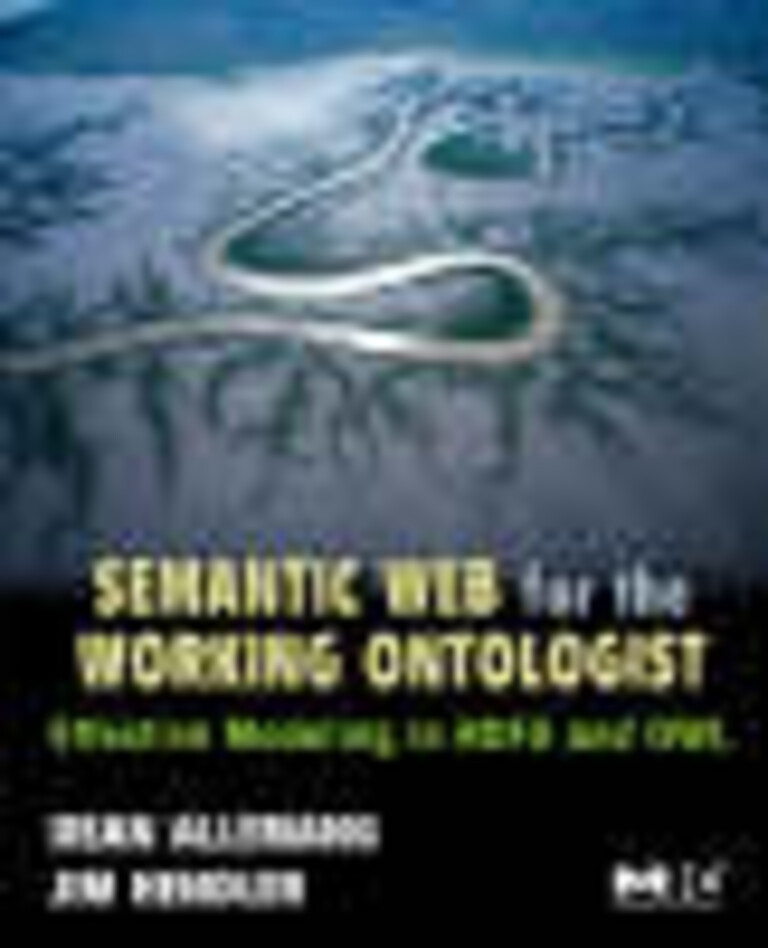Semantic web for the working ontologist : modeling in RDF, RDFS and OWL
Dean Allemang, James Hendler
Bok Engelsk 2008 · Electronic books.
| Utgitt | Burlington, MA : Morgan Kaufmann Publishers , 2008
|
|---|---|
| Omfang | XVII, 330 s. : ill.
|
| Opplysninger | Description based upon print version of record.. - Front Cover; Semantic Web for the Working Ontologist Modeling in RDF, RDFS and OWL; Copyright Page; Contents; Preface; About the Authors; Chapter 1: What Is the Semantic Web?; What Is a Web?; Smart Web, Dumb Web; Smart Web Applications; A Connected Web Is a Smarter Web; Semantic Data; A Distributed Web of Data; Features of a Semantic Web; What about the Round-Worlders?; To Each Their Own; There's Always One More; Summary; Fundamental Concepts; Chapter 2: Semantic Modeling; Modeling for Human Communication; Explanation and Prediction; Mediating Variability; Variation and Classes. - Equivalent Properties. - Nonmodeling Properties in RDFSCross-Referencing Files: rdfs:seeAlso; Organizing Vocabularies: rdfs:isDefinedBy; Model Documentation: rdfs:comment; Summary; Fundamental Concepts; Chapter 7: RDFS-Plus; Inverse; Challenge: Integrating Data that Do Not Want to Be Integrated; Challenge: Using the Modeling Language to Extend the Modeling Language; Challenge: The Marriage of Shakespeare; Symmetric Properties; Using OWL to Extend OWL; Transitivity; Challenge: Relating Parents to Ancestors; Challenge: Layers of Relationships; Managing Networks of Dependencies; Equivalence; Equivalent Classes. - Other Data Sources-Converters and ScrapersRDF Store; RDF Data Standards and Interoperability of RDF Stores; RDF Query Engines and SPARQL; Comparison to Relational Queries; Application Code; RDF-Backed Web Portals; Data Federation; Summary; Fundamental Concepts; Chapter 5: RDF and Inferencing; Inference in the Semantic Web; Virtues of Inference-Based Semantics; Where Are the Smarts?; Asserted Triples versus Inferred Triples; When Does Inferencing Happen?; Inferencing as Glue; Summary; Fundamental Concepts; Chapter 6: RDF Schema; Schema Languages and their Functions. - Variation and LayersExpressivity in Modeling; Summary; Fundamental Concepts; Chapter 3: RDF-The Basis of the Semantic Web; Distributing Data Across the Web; Merging Data from Multiple Sources; Namespaces, URIs, and Identity; Expressing URIs in Print; Standard Namespaces; Identifiers in the RDF Namespace; Challenge: RDF and Tabular Data; Higher-Order Relationships; Alternatives for Serialization; N-Triples; Notation 3 RDF (N3); RDF/XML; Blank Nodes; Ordered Information in RDF; Summary; Fundamental Concepts; Chapter 4: Semantic Web Application Architecture; RDF Parser/Serializer. - What Does it Mean? Semantics as InferenceThe RDF Schema Language; Relationship Propagation through rdfs:subPropertyOf; Typing Data by Usage-rdfs:domain and rdfs:range; Combination of Domain and Range with rdfs:subClassOf; RDFS Modeling Combinations and Patterns; Set Intersection; Property Intersection; Set Union; Property Union; Property Transfer; Challenges; Term Reconciliation; Instance-Level Data Integration; Readable Labels with rdfs:label; Data Typing Based on Use; Filtering Undefined Data; RDFS and Knowledge Discovery; Modeling with Domains and Ranges; Multiple Domains/Ranges. - The promise of the Semantic Web to provide a universal medium to exchange data information and knowledge has been well publicized. There are many sources too for basic information on the extensions to the WWW that permit content to be expressed in natural language yet used by software agents to easily find, share and integrate information. Until now individuals engaged in creating ontologies-- formal descriptions of the concepts, terms, and relationships within a given knowledge domain-- have had no sources beyond the technical standards documents. Semantic Web for the Working Onto
|
| Emner | RDF (Resource Description Framework)
Metadata Semantic Web Web site development Vis mer... Web site development. Metadata. Semantic Web.
Electrical & Computer Engineering Engineering & Applied Sciences Ontologi Ontologier Semantisk web Semantiske nettverk Telecommunications Web ontology language Metadata((NO-TrBIB)HUME19175) Ontologi((NO-TrBIB)HUME00589) Ontologier((NO-TrBIB)HUME00589) Ontologier((NO-TrBIB)REAL014039) Semantisk web((NO-TrBIB)REAL014037) Semantiske nettverk((NO-TrBIB)HUME04209) Web ontology language((NO-TrBIB)REAL003561) semantisk web metadata ontologier |
| Sjanger | |
| Dewey | 025.04 All . - 025.04
|
| ISBN | 9780123735560
|
